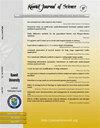艰难梭菌毒素TcdA和TcdB催化结构域与SuperNatural 3.0数据库中部分化合物的硅相互作用
IF 1.2
4区 综合性期刊
Q3 MULTIDISCIPLINARY SCIENCES
引用次数: 0
摘要
艰难梭菌是一种致病菌,可导致全球抗生素相关性腹泻。这种细菌的发病机制是由于其毒力毒素,它使宿主细胞中Rho和Ras家族的小gtpase失活,导致艰难梭菌感染的建立。为了避免这种感染,我们利用分子对接分析从SuperNatural 3.0中筛选了TcdA和TcdB催化糖基转移酶结构域的化合物。酶和化合物被输入到PyRx虚拟筛选软件中,并相应地对接。对接后的交互使用Discovery Studio软件进行可视化。TcdA和TcdB与酶的结合能分别在−8.9 ~−11.4 kcal/mol和−7.6 ~−11.2 kcal/mol之间,具有较强的结合亲和力。具有潜在药物发现潜力的配体的结合能小于- 6.0 kcal/mol(或在某些情况下为- 8.0 kcal/mol)。这与毒素中发现的分子和氨基酸之间的氢键和其他相互作用有关。药代动力学分析显示,这些化合物相对安全,SN0161212、SN0032215和SN0084749符合Lipinski的五法则,没有预测会引起人肝毒性或药物性肝损伤。本研究结果表明,SuperNatural 3.0化合物(SN0161212、SN0032215和SN0084749)具有抑制艰难梭菌毒素的潜力。因此,这些化合物可以作为设计抗艰难梭菌毒素的有效抑制剂的垫脚石。本文章由计算机程序翻译,如有差异,请以英文原文为准。

In silico interaction of catalytic domain of Clostridioides difficile toxins TcdA and TcdB with some selected compounds from the SuperNatural 3.0 database
Clostridioides difficile is a pathogenic bacterium responsible for antibiotic-associated diarrhea globally. The pathogenesis of this bacterium is due to its virulence toxins, which inactivate the small GTPases from the Rho and Ras families in host cells, leading to the establishment of Clostridioides difficile infection. In a bid to avert this infection, compounds from SuperNatural 3.0 were screened against the catalytic glucosyltransferase domains of TcdA and TcdB using molecular docking analysis. The enzymes and the compounds were imported into the PyRx virtual screening software and docked accordingly. Post-docking interactions were visualized using Discovery Studio software. The binding energies resulting from the interaction of the compounds and the enzymes were within the range of −8.9 to −11.4 kcal/mol and −7.6 to −11.2 kcal/mol for TcdA and TcdB respectively, suggesting fairly strong binding affinities. Ligands that have the potential to be considered for drug discovery have binding energy less than −6.0 kcal/mol (or −8.0 kcal/mol in some cases). This is associated with the hydrogen bonds and other interactions between the molecules and the amino acids found within the toxins. The pharmacokinetic profiling revealed the compounds to be relatively safe, with SN0161212, SN0032215, and SN0084749 passing Lipinski's rule of five, with none predicted to cause human hepatotoxicity or drug-induced liver injury. The findings from this research suggest that the SuperNatural 3.0 compounds (SN0161212, SN0032215, and SN0084749) possessed the potential to inhibit Clostridioides difficile toxins. Hence, the compounds could serve as a stepping stone in designing potent inhibitor(s) against Clostridioides difficile toxins.
求助全文
通过发布文献求助,成功后即可免费获取论文全文。
去求助
来源期刊

Kuwait Journal of Science
MULTIDISCIPLINARY SCIENCES-
CiteScore
1.60
自引率
28.60%
发文量
132
期刊介绍:
Kuwait Journal of Science (KJS) is indexed and abstracted by major publishing houses such as Chemical Abstract, Science Citation Index, Current contents, Mathematics Abstract, Micribiological Abstracts etc. KJS publishes peer-review articles in various fields of Science including Mathematics, Computer Science, Physics, Statistics, Biology, Chemistry and Earth & Environmental Sciences. In addition, it also aims to bring the results of scientific research carried out under a variety of intellectual traditions and organizations to the attention of specialized scholarly readership. As such, the publisher expects the submission of original manuscripts which contain analysis and solutions about important theoretical, empirical and normative issues.
 求助内容:
求助内容: 应助结果提醒方式:
应助结果提醒方式:


